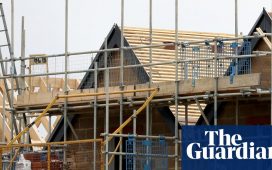The number of UK first-time buyers getting on the housing ladder is on track to hit a 10-year low as higher mortgage rates make purchasers more reliant on the so-called Bank of Mum and Dad.
The number of mortgages obtained by first-time buyers is down nearly one quarter so far this year compared with 2022, according to data from trade body UK Finance. If the trend continues through to December 31, as analysts expect, it would mark the fewest first home purchases since 2013.
First-time buyers have suffered from the end of the government’s Help to Buy loan scheme in March, as well as the sharp rise in mortgage costs from near 2 per cent on average in early 2022 to about 5 per cent today, forcing them to lean more on their families for financial help.
“It’s not just about the numbers who are buying. It’s about who is buying, and the social consequences of who is able to buy,” said Lucian Cook, head of residential research at estate agency Savills.
Cook said the number of first-time buyers was actually higher than some analysts had expected, given the mortgage shock, “but that is very heavily reliant on the Bank of Mum and Dad to help them get there”.
Demand from people seeking to join the housing ladder remains high, driven partly by record rent rises, but expensive mortgages mean fewer people can afford to do so.
It has become harder to buy on a single income. Couples buying together make up two-thirds of first-time buyers, up from half a decade ago, according to research company Capital Economics. Meanwhile, the percentage receiving financial help from parents had soared to about 60 per cent this year, up from 46 per cent in 2022, according to Savills.

Tim Bannister, director of property data at online property portal Rightmove, said many buyers were “looking at cheaper locations, smaller homes, or extending mortgage terms in order to still find a home that suits their budget and needs”.
On average, people leaving London to purchase their first home moved a record 25.5 miles outside the capital this year, committing to longer commutes and searches further afield for affordable homes, according to research by estate agency Hamptons.
The plight of first-time buyers and access to housing is set to become a central battleground in the general election next year.
Labour, which holds a roughly 18-point lead over the governing Conservatives in opinion polls, has pledged to become “the party of home ownership” and set a target of 70 per cent home ownership across the UK if it returns to power.
“I think that Labour has sensed an opportunity given the fall we have seen in first-time buyer activity,” said Cook.
The main opposition party has promised to boost housebuilding, proposed a new mortgage guarantee scheme to help first-time buyers, and said it wanted to give them first dibs on newly built homes before they were offered to people higher up the property ladder.

Higher borrowing costs have also put the brakes on the broader housing market. About 1mn homes will be sold by the end of 2023, according to research by property portal Zoopla, the lowest in a decade and well below the long-term average of 1.2mn.
Separate analysis by Savills found that, in the first nine months of 2023, the share of total spending on house purchases coming from cash buyers rose to 45 per cent, the highest since at least 2007. Meanwhile, the proportion funded by mortgages fell to less than 40 per cent, the lowest in more than 15 years.
Far fewer families are upsizing to new homes, with borrowers unable to afford higher mortgage repayments and keen to hold on to cheaper rates until the very end of their current fixed-term deals.
UK Finance estimated that another 1.5mn homeowners would have to remortgage in 2024 when their fixed rate ended. “We’re only half way through the transition of today’s mortgages moving on to higher rates,” said Richard Donnell, executive director at Zoopla.
Despite the mortgage pain, house prices had been more resilient than some analysts expected. UK house prices decreased by 1.2 per cent in the 12 months to October, according to the Office for National Statistics. Analysts forecast that prices would fall further, by low single-digit percentages, in 2024.

Donnell said prices had held up better than some predicted in part because of tougher regulation around mortgages and more forbearance from lenders than during the 2008 housing downturn, which meant fewer forced sales undercutting the market.
But the same regulations, which impose tougher stress tests on prospective borrowers, have made it harder for first-time buyers to obtain mortgages. Some would-be buyers find that they cannot secure a mortgage even when they are paying the same amount or more in monthly rent.
In most regions, mortgage payments were cheaper than rents for equivalent properties on a typical 85 per cent loan-to-value mortgage, according to Zoopla. If buyers can pull together a larger deposit, often with help from family, a 75 per cent loan-to-value makes buying cheaper than renting across the country.

But stress tests mean borrowers have to prove they can afford significantly more than what their mortgage payments will actually be, blocking some from being able to buy.
The increased hurdles for first-time buyers have added to the number of people in private rented homes, contributing to pressure on rents.
“Stress testing makes it more expensive, basically. This is why a lot of young people are angry,” said Donnell. “If you’re on a low-to-mid income and you’re renting, you could well be trapped in there for longer.”










